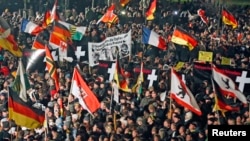Seventy years have passed since Allied bombing raids killed 25,000 people and laid waste its Baroque churches and palaces, but resentment still lingers in Dresden, providing fertile soil for far-right and anti-Muslim groups.
Every year on Feb. 13, neo-Nazis from all over Europe gather to commemorate what they call the "bombing holocaust" unleashed on the German city less than three months before the end of World War Two.
This year some fear the emergence of PEGIDA, an anti-Islam group which warns of Germany being overrun by Muslims, will boost the traditional far-right rally and overshadow a ceremony with European dignitaries.
Uncertainty about the death toll and whether the city was a legitimate target fed a "myth of victimhood" that Dresden's suffering was unique. It was invented by the Nazis, usurped by East German Communists and then assumed by the far right.
“How can you justify killing so many civilians so near the end of the war? Of course we still feel it. It was a war crime,” said Michael Pickert, 47, at a PEGIDA rally last month.
The group, whose initials in German stand for Patriotic Europeans Against the Islamisation of the West, has plunged into disarray since its leader resigned last month over pictures showing him posing as Hitler. Five founding members then quit to set up a rival movement.
On Monday evening, about 2,000 people joined PEGIDA's regular Monday night rally in Dresden, a far cry from the roughly 25,000 it drew earlier this year. An anti-racism demonstration last month attracted 35,000 people, showing there is also strong opposition in the city to right-wing attitudes.
But even if it proves a flash in the pan, PEGIDA has shaken Germany. Chancellor Angela Merkel said some of its members had “hatred in their hearts”, and Foreign Minister Frank-Walter Steinmeier acknowledged it had damaged the country's reputation.
Why Dresden?
Historians say the events of February 1945 explain at least part of the reason why the far-right has broader appeal in this eastern city than in the rest of the country.
Helped by good visibility and a lack of German anti-aircraft guns, British planes pounded Dresden with a lethal mix of explosive and incendiary bombs on the night of Feb. 13, creating a firestorm that tore through the streets.
In the next two days, U.S. planes joined the attack, hampering efforts to retrieve the dead and wounded. In a total of four raids, the Allies dropped at least 3,900 tons of bombs. The mission to cause chaos and destroy civilian morale was accomplished.
“It's the raid that went horribly right,” said historian Frederick Taylor.
Dresden was not alone. Other cities, including Hamburg, Pforzheim in the Black Forest, and industrial towns in the Ruhr, suffered tens of thousands of victims from aerial bombing.
Yet for Dresden it was a defining moment, said Matthias Rogg, director of Germany's Military History Museum in the city.
“It's the point from which everything is measured. It fed the myth that Dresden was the innocent victim of a pointless war and hid the fact that it was a center of Nazism and a significant hub for making armaments,” he told Reuters.
“And while the bombing of Dresden was dreadful, it's crucial that without Sept. 1, 1939, without Warsaw, Rotterdam, Coventry, London, there wouldn't have been Dresden,” said Rogg, recalling the date of the Nazi invasion of Poland and a string of foreign cities bombarded or blitzed by Hitler's forces.
Immediately after the Dresden raids, officials estimated the death toll at 25,000, but kept it secret. Over the years the numbers were inflated, sometimes even to 500,000. This suited Communists keen to besmirch the “western Imperialist” foe. After the Berlin Wall fell, it was the turn of the far right to use it to stoke resentment.
“You can't underestimate how central inflating the Dresden air raid figures is to the far right. It's a key for rousing mass support, like a religious belief,” Taylor told Reuters.
In 2010 a Historical Commission put the official number at up to 25,000, close to the original, concealed figures.
Cigarettes to bullets
Dresden was known as the 'Florence of the Elbe' for its cultural splendors including the Semper opera and domed Frauenkirche, a church left as a symbolic ruin until it was rebuilt after Germany's reunification.
But historians say it also housed legitimate targets. A cigarette plant produced bullets; camera makers turned to torpedo guidance systems; major rail lines converged there.
Taylor says he considers the bombing of Dresden to be “morally questionable.”
“The city has been largely rebuilt but the trauma is intense. It's never recovered from a diffuse grief and cultural pessimism,” he said. This climate is hospitable to groups like PEGIDA which feed on fears and grievances, he added.
Today, with a population of about half a million, the capital of the state of Saxony is held up as a rare East German success story. Chancellor Angela Merkel's conservatives have ruled the state since reunification almost 25 years ago.
But a state election last year showed that almost 15 percent of voters favored right-leaning parties: the far-right National Democratic Party (NPD) and the new Alternative for Germany (AfD), which has homed in on anxiety about immigration.
Against this backdrop, the museum's Rogg said he feels a special responsibility to deconstruct the myth. “One of our most important messages is that the picture is multi-faceted.”
Many witnesses to the bombing have described horrifying hours cowering in basements while their houses and families burned around them.
“Screaming people burning like torches passed us and collapsed. We couldn't stay upright so crawled on all fours. Utter chaos surrounded us,” wrote Peter Hoffmann, born in 1932.
Yet there are other stories too, like those of dozens of Jewish forced laborers who escaped deportation to concentration camps thanks to the chaos unleashed by the firestorm.









